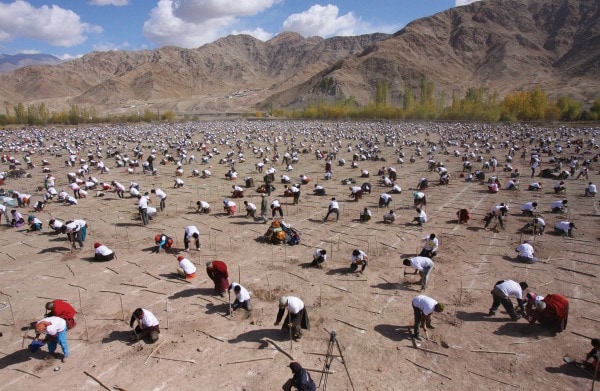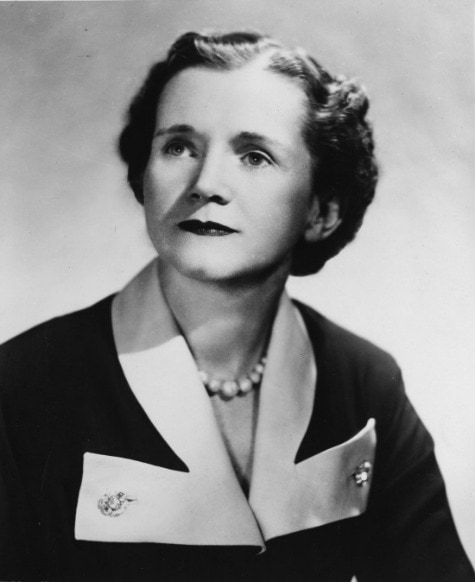
In honor of Earth Day being this month, I thought I would bring back my Aesthetics and Activism series and talk about a movement that inspired a lifestyle, rather than a specific trend: Today, we’re discussing the history of the environmental movement.
Table of Contents
The Root of The Problem
Even though the environmental movement had existed in different forms for many years, the modern environmental movement we know today didn’t really begin until the mid-20th century.
This movement was first sparked by the wars and the pollution they created. By the 1950s, increased industrial production for the two back-to-back war efforts had created a lot of waste and pollution. Also, after WWII, there was a huge surge in consumerism as the economy boomed. Many new technologies were cropping up every day and these items were being mass-produced and distributed to people all over the world.
This combination led to increased pollution from factories and increased waste since people were consuming more. Next, naturally, came the pushback.
Silent Spring: A Call to Action
The environmental movement first gained mainstream attention when Rachel Carson published Silent Spring, a novel that highlighted the environmental problems that humans were causing. The book, still available here, focused primarily on DDT, an extremely powerful pesticide that had become available for consumer use in 1945. It was originally developed to kill malaria-carrying bugs in the South Pacific and had proven very effective. But, as you probably know now, it was much more dangerous than other pesticides of its time because it didn’t just target one or two types of organisms. Indeed, it was able to do harm on a much larger scale.
In her novel, Carson presented a study that she had conducted over four years, examining the effects of DDT on animals and the food chain. She found that the pesticide contained toxic, cancer-causing chemicals that affected both animals and humans. Also, she found that DDT was so strong that it wasn’t diluted by water, meaning that neither rain nor washing your food would be able to completely eliminate it.
When people heard about this, they were outraged and scared. Although the environmental movement had been gaining traction for a while, Silent Spring was a massive hit that rocketed environmentalism into the national conversation. For the first time, people everywhere began to really think about what they were doing to the planet.

The Impact of Silent Spring
Once people identified the problem, they had to decide what to do about it. In Silent Spring’s wake, many legislators worked on bills to protect nature and wildlife. During the ’70s in particular, there was a big push to clean up rivers that had become polluted from factory chemicals.
On a more general scale, people started to become more conscious of where they bought their things and how those things were made. Organic produce soon became popular for the first time.
People also began looking for ways to be more responsible with the things they owned. This led to the popularity of the Three Rs: Reduce, Reuse, Recycle. This principle focused on consuming less in different steps. Not only did it emphasize using less but it also stressed finding alternative ways to use products or waste (like leftover packaging) and responsibly disposing of whatever was left over.
Fashion and Sustainability
Even though the fashion industry is rooted in consumerism and centers around all things new, it was actually one of the places where the environmental movement had the greatest impact.
By the mid-20th century, consumers had more options than ever in terms of places to shop. Therefore, for the first time, if a company’s practices didn’t line up with a consumer’s values, said consumer could decide not to shop with them. This gave power to consumers in a manner not previously seen.
Consumer power had a big effect on the fashion industry. In the later part of the century, consumer demand grew for fabrics that were grown and harvested sustainably. Also, the treatment of workers became a mainstream issue (particularly in the ’90s) and the debate about ethical labor practices heavily influenced where people shopped.
The popularity of the DIY movement also created a stir in the industry because people were buying less. This showed the power that the consumer held: DIYers no longer had to rely solely on companies; because they learned how to make their own products, they could avoid buying from businesses whose practices they didn’t support.
For all of these reasons, by the end of the 20th century, fashion businesses had to listen to consumers. They adapted their practices and advertised these new practices. The height of the environmental and ethical consumerism movement occurred in the early 2000s, but the movement is still going strong today.

The Environmental Movement Today
Today, we can still see the effects of the earlier environmental movements, particularly in the fashion industry. For example, H&M, one of the most popular fast fashion retailers, now has a “Conscious” line of clothing that specializes in using sustainable methods and recycled fabrics. This line was created in direct response to consumer demand for things like organic cotton. These days, we have more access than ever to information about how their things are made, so it’s easier than ever to support companies whose values align with ours.
Additionally, recycling has turned into upcycling in the fashion world. Today, people find old clothes that are still in good condition and breathe new life into them by turning them into new and improved pieces rather than throwing them away. This DIY spirit allows people to reduce their amount of waste, while embracing consumer demand for customized goods.
E-commerce has allowed recyclers, upcyclers, and DIYers to capitalize on these movements. Sites like Etsy, eBay, and Depop let people sell their creations and even their old clothes to the world, reducing waste worldwide.
From its beginnings in post-war pollution to its widespread popularity today, the environmental movement has come a long way and continues to grow. This is particularly evident in the fashion industry, where things are not perfect but improvements have been made. It will be interesting to see where the movement goes from here, but to me, continued growth is inevitable. After all, if there’s one thing we can all agree upon, it’s that we love this little planet that we call home.
Conscious Consumerism Reading List
Want to become an upcycler or DIY goddess? Below, I’ve included some links to DIY projects and blogs, as well as some additional reading on sustainability and environmentalism.
- Our DIY project archive has tons of fashion and home decor tutorials from easy to expert – check them out if you haven’t seen them already!
- Upcycle That is a website that focuses on finding things that would usually be thrown out and using them in new ways. There are so many cool decor ideas here!
- This article highlights upcycling in fashion and is a great resource for people who want to learn more about the concept before jumping in.
- This website has a list of cool projects that will give you plenty of inspiration for upgrading your wardrobe.
- This Refinery29 article on zero-waste grocery shopping looks at how we can make our food shopping more green.
- This website is entirely focused on sustainability and what’s happening within the fashion and beauty world regarding ethical consumerism.
What do you think?
Have you ever tried upcycling? Are there any cool DIYs you’ve used to avoid throwing away old things? What are your thoughts on how consumerism effects the environment?

interesting article is great to be aware of the power we have as consumers. Although I wish the dabate about the disgraceful treatment and low pay of workers for fast fahion rateilers could get more attention